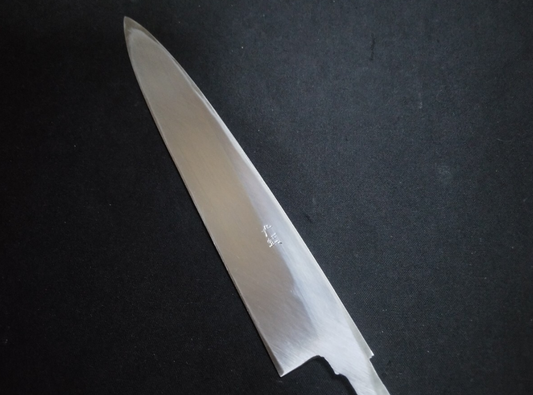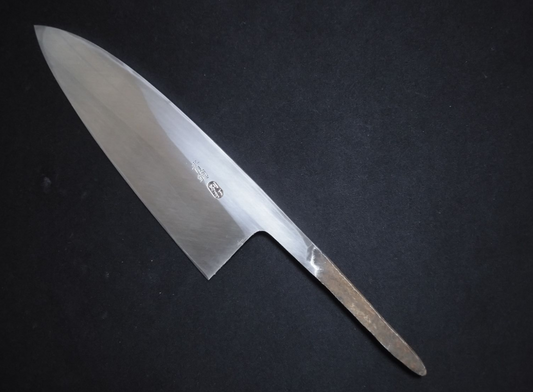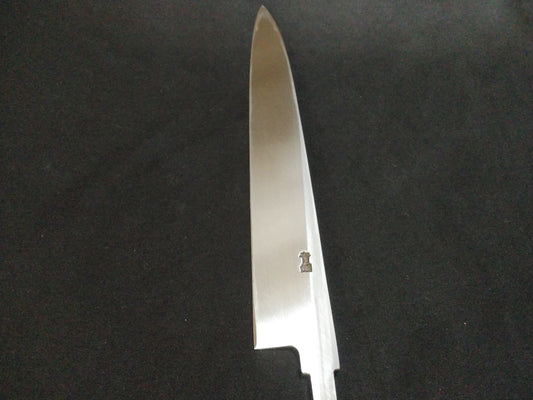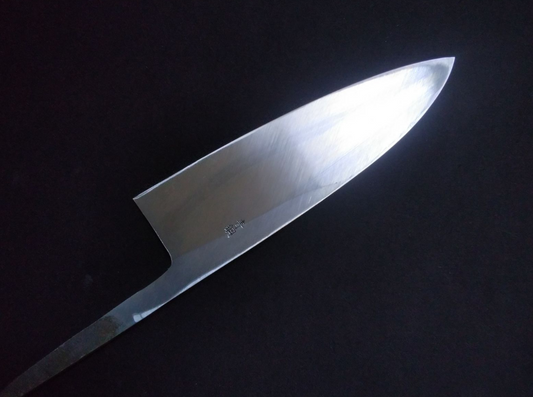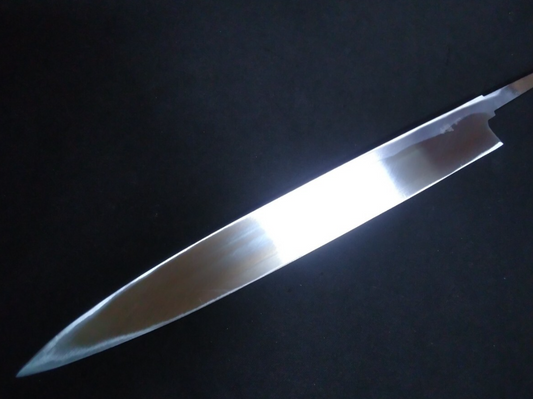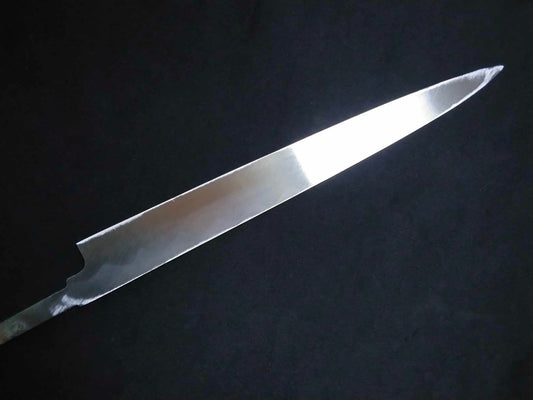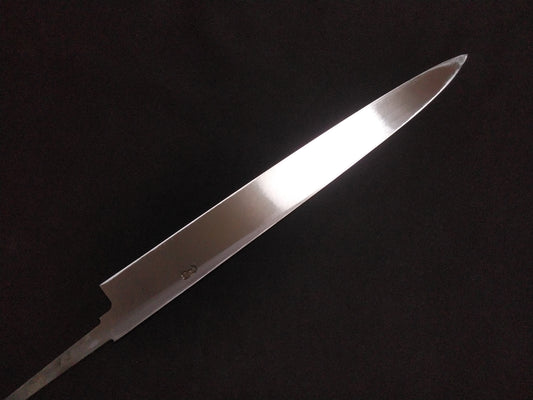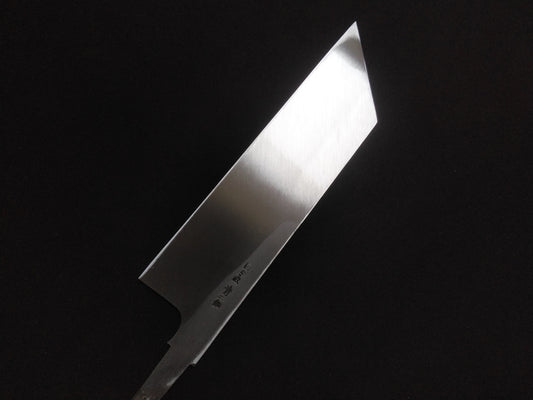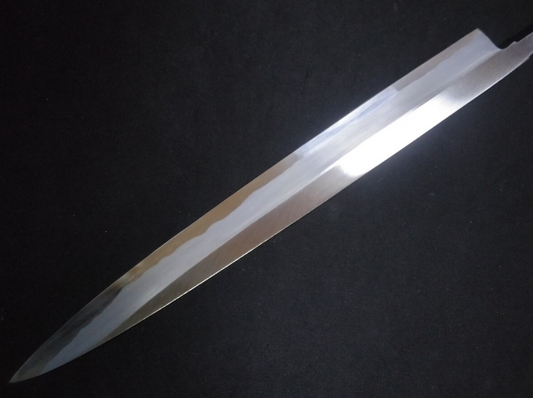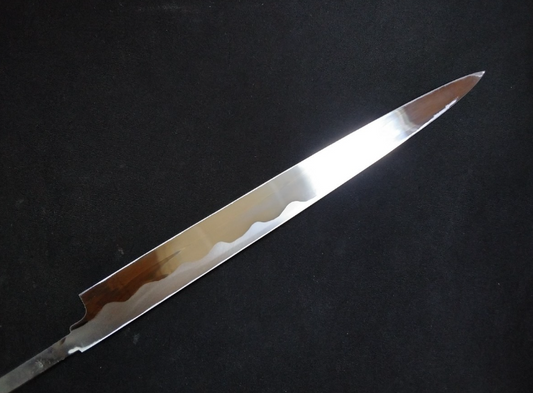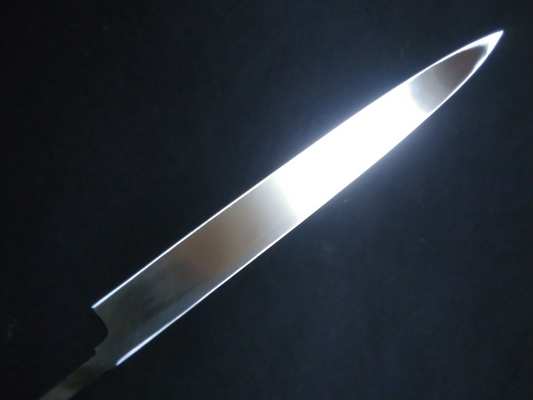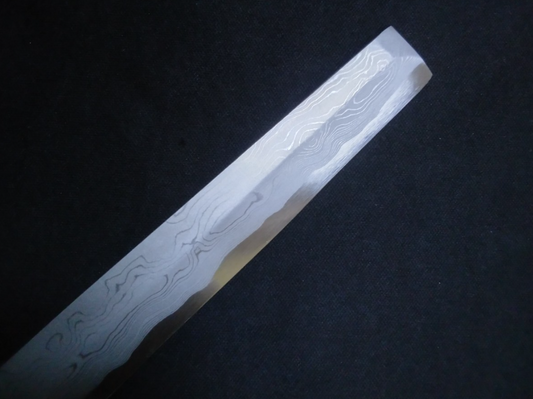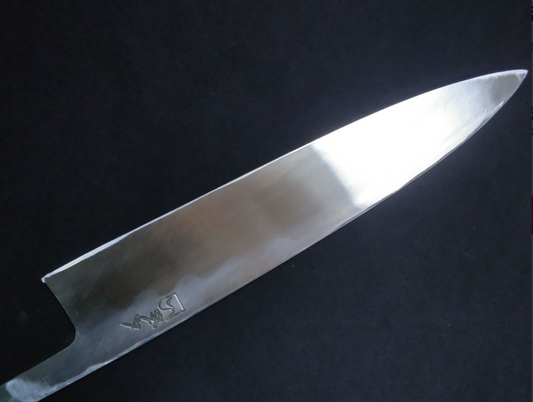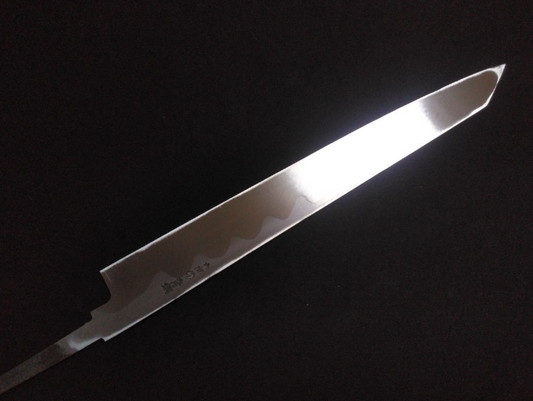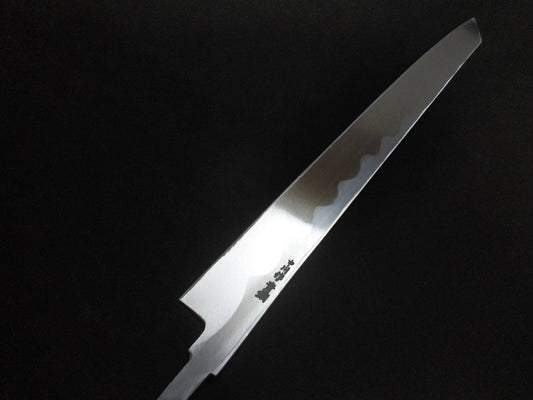
Blue Steel #2
-
The Perfect Balance Between Sharpness and Strength
In the world of Japanese knives, Blue Steel #2 is trusted by chefs who need both performance and durability.
Born from pure White Steel #2 with the addition of chromium and tungsten, it keeps its razor edge longer, resists chipping, and offers a silky-smooth sharpening experience.
From the first slice of the day to the last plate of service, this steel stands by you—quietly, reliably, and with a touch of tradition in every cut. -
Blue Steel #2 Japanese Knife Collection
-
Blue Steel #2 Yanagiba 210mm- Kido Finishing
Regular price $300.00 CADRegular priceUnit price / per$0.00 CADSale price $300.00 CAD -
Blue Steel #2 Deba 165mm- Kido Finishing
Regular price $310.00 CADRegular priceUnit price / per$0.00 CADSale price $310.00 CAD -
Blue Steel #2 Yanagiba 240mm-Mirror Polished(one side)
Regular price $330.00 CADRegular priceUnit price / per$0.00 CADSale price $330.00 CAD -
Blue Steel #2 Deba 165mm- Mirror Polished(one side)
Regular price $340.00 CADRegular priceUnit price / per$0.00 CADSale price $340.00 CAD -
Blue Steel #2 Yanagiba 270mm- Kido Finishing
Regular price $350.00 CADRegular priceUnit price / per$0.00 CADSale price $350.00 CAD -
Blue Steel #2 Yanagiba 270mm- Mirror Polished(one side)
Regular price $385.00 CADRegular priceUnit price / per$0.00 CADSale price $385.00 CADSold out -
Blue Steel #2 Yanagiba 300mm-Mirror Polished(one side)
Regular price $407.00 CADRegular priceUnit price / per$397.00 CADSale price $407.00 CADSold out -
Blue Steel #2 Gyuto 270mm-Kido Finishing
Regular price $420.00 CADRegular priceUnit price / per$0.00 CADSale price $420.00 CADSold out -
Blue Steel #2 Mukimono 190mm-Mirror Polished(one side)
Regular price $445.00 CADRegular priceUnit price / per$445.00 CADSale price $445.00 CADSold out -
Blue Steel #2 Yanagiba 360mm- Kido Finishing
Regular price $450.00 CADRegular priceUnit price / per$0.00 CADSale price $450.00 CAD -
Blue Steel #2 Yanagiba 300mm -Mirror Polished(both sides)
Regular price $460.00 CADRegular priceUnit price / per$460.00 CADSale price $460.00 CADSold out -
Blue Steel #2 Yanagiba 330mm -Mirror Polished(one side)
Regular price $460.00 CADRegular priceUnit price / per$460.00 CADSale price $460.00 CADSold out -
Blue Steel #2 Damascus Takohiki 240mm- Mirror Polished Blur Finish
Regular price $470.00 CADRegular priceUnit price / per$0.00 CADSale price $470.00 CAD -
Blue Steel #2 Deba 240mm- Mirror Polished(one side)
Regular price $500.00 CADRegular priceUnit price / per$0.00 CADSale price $500.00 CAD -
Blue Steel #2 Yanagiba(Kiritsuke) 270mm-Mirror Polished(one side)
Regular price $517.00 CADRegular priceUnit price / per$0.00 CADSale price $517.00 CADSold out -
Blue Steel #2 Yanagiba(Kiritsuke) 330mm-Mirror Polished(one side)
Regular price $600.00 CADRegular priceUnit price / per$0.00 CADSale price $600.00 CADSold out
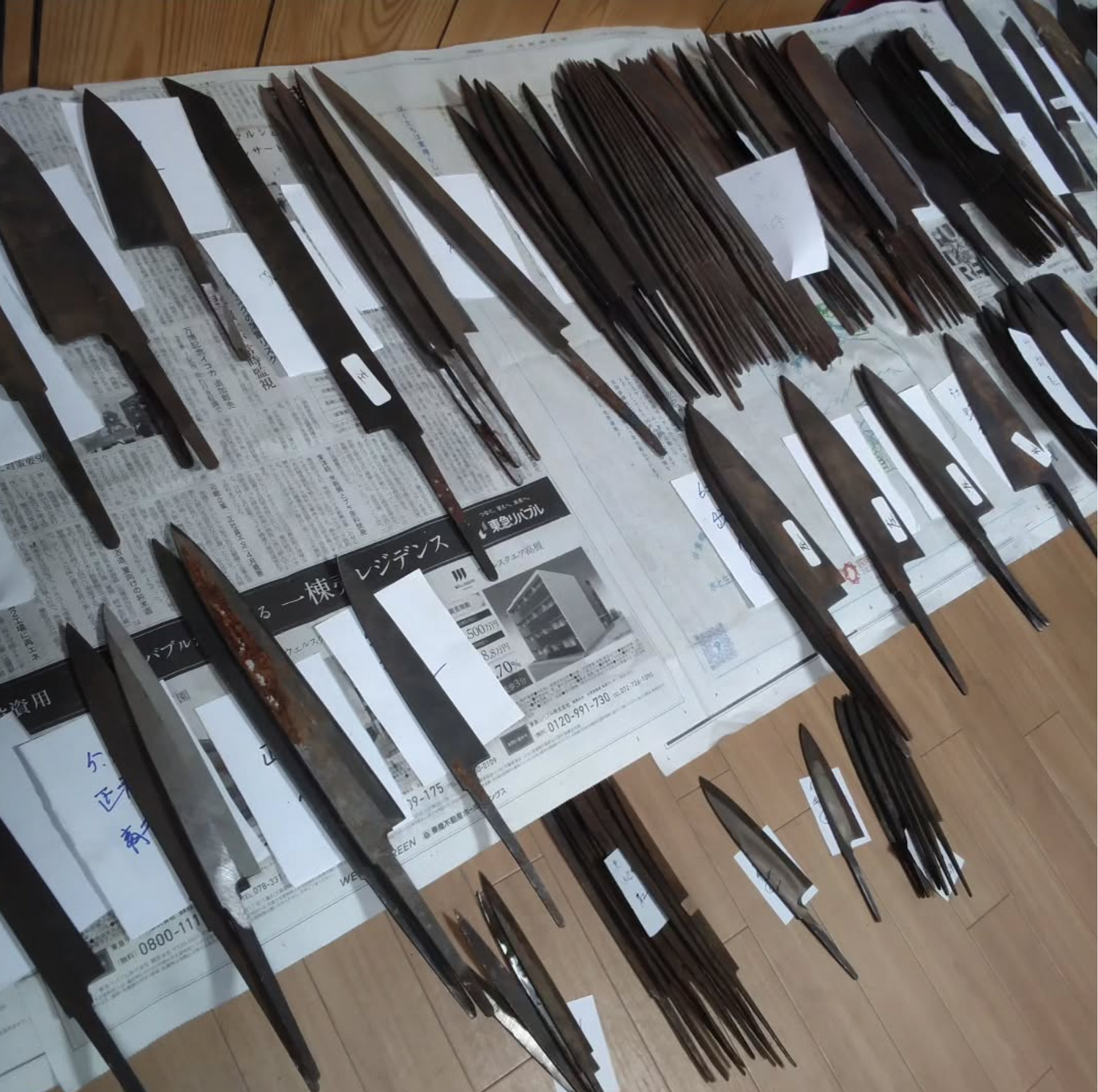
New Arrival Notice: Inherited Blades from a Retiring Blacksmith
From a blacksmith closing his forge, we’ve received a rare stock of hand-forged Blue Steel blanks—shaped with pine charcoal and time-honored skill.
They will now be entrusted to master sharpeners.
If you're seeking a specific type, steel, or size, please contact us.
At KIREAJI, we honor not just craftsmanship, but the tradition behind it.
KIREAJI's Three Promises to You
-

1. Forged in the Legacy of Sakai
From Sakai City—Japan’s renowned birthplace of professional kitchen knives—each blade is crafted by master artisans with over six centuries of tradition. Perfectly balanced, enduringly sharp, and exquisitely finished, every cut carries the soul of true craftsmanship.
-

2. Thoughtful Care for Everyday Use
Every knife includes a hand-fitted magnolia saya for safe storage. Upon request, we offer a complimentary Honbazuke final hand sharpening—giving you a precise, ready-to-use edge from day one.
-

3. A Partnership for a Lifetime
A KIREAJI knife is more than a tool—it is a lifelong companion. With our bespoke paid aftercare services, we preserve its edge and beauty, ensuring it remains as precise and dependable as the day it first met your hand.
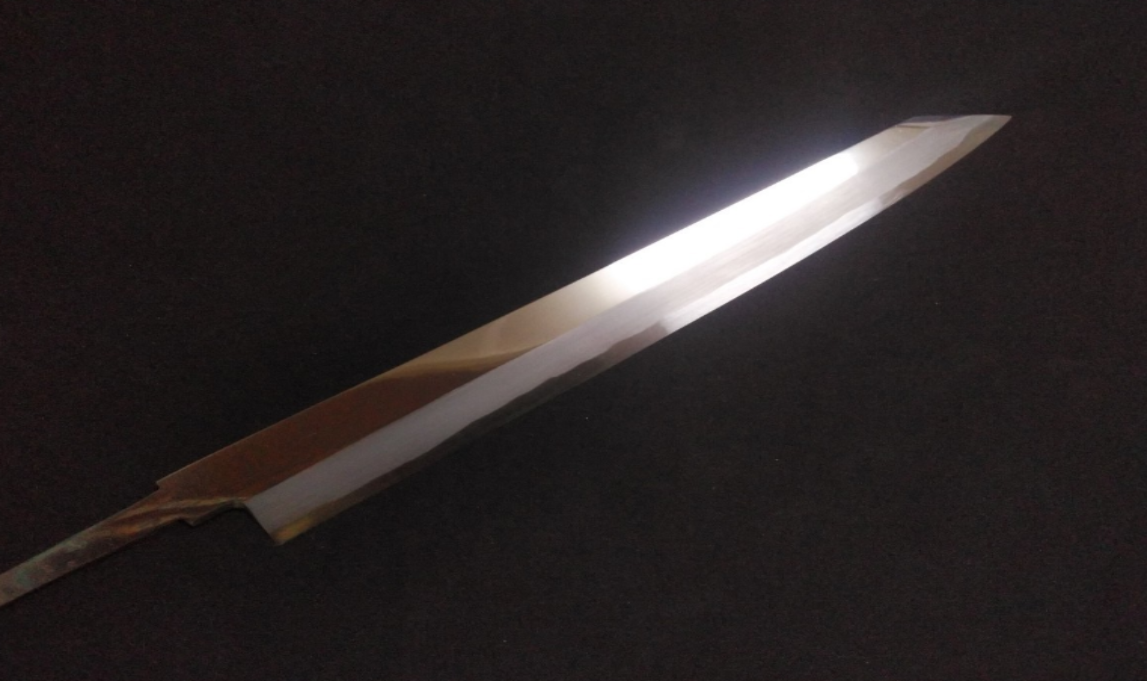
Why Many Product Photos Show Only the Blade
At KIREAJI, every knife is made to order in Sakai, Japan. Photos show the blade before the handle is attached, allowing artisans to perfect the balance and edge for your specific order. Your knife arrives fully finished — tailored just for you.

Global Delivery from Sakai
Across the world, discerning cooks seek authentic Japanese knives from Sakai — Japan’s legendary knife-making city with over 600 years of tradition.
At KIREAJI, we work alongside master artisans in Sakai to fulfill that desire, shipping genuine handcrafted knives directly from the workshop to kitchens worldwide.
Blue Steel #2
-
The Perfect Balance of Sharpness and Toughness — Why Blue Steel #2 Wins the Trust of Professional Chefs
In the world of cooking, finding “the one knife you can truly trust” is a life-changing experience.
Blue Steel #2 is just that kind of steel—one that meets the needs of both professional chefs and passionate home cooks alike. -

What Is Blue Steel #2?
Blue Steel #2 (Aogami #2) is a premium high-carbon alloy steel produced by Hitachi Metals under the Yasugi Steel brand.
It is based on White Steel #2, with the addition of chromium and tungsten, enhancing its performance in key areas.These added elements give Blue Steel #2 greater wear resistance and durability, while still preserving the razor-sharp edge that White Steel is known for.
Think of it as a hybrid steel—combining refined sharpening characteristics with practical toughness. -
Long-Lasting Sharpness You Can Count On
In busy kitchens where prep work is constant and time is limited, a knife that holds its edge longer becomes an indispensable ally.
While White Steel offers outstanding sharpness, Blue Steel #2 brings that sharpness with endurance—cutting through fish, vegetables, or meat all day long without constant touch-ups.Thanks to the added chromium and tungsten, Blue Steel #2 is also more resistant to chipping and micro-fractures, making it highly valued in fast-paced environments where reliability matters most.
-
A More Forgiving Carbon Steel
Although it’s still carbon steel and not stainless, Blue Steel #2 is slightly more rust-resistant than White Steel.
With basic care—wipe it down after use, keep it dry—it becomes a very manageable material, even for those unfamiliar with carbon steels.And for sharpening enthusiasts, the real joy begins on the whetstone.
The feedback when sharpening Blue Steel #2 is incredibly smooth, offering that uniquely satisfying sensation as the blade glides over stone—like having a conversation with the steel itself. -

Blue Steel #2 Teaches You to Appreciate the Act of Cooking
Cooking isn’t just about cutting food—
It’s about listening to the ingredients, applying your technique with care, and pouring your heart into every motion.
A Blue Steel #2 knife becomes more than just a tool—it becomes a partner in creation.Whether you're plating a refined dish or preparing meals for a crowd, this steel supports you silently, skillfully, and consistently.
-
Summary
Blue Steel #2 is:
- A well-balanced carbon steel that combines the sharpness of White Steel #2 with the durability of alloy elements
A material that offers excellent edge retention, ideal for high-volume professional use - Easy to sharpen and maintain with minimal care
- A steel that becomes more comfortable and personal the more you use it, deepening your connection with the craft
If you're a chef who wants to refine your skills, or a serious home cook seeking a deeper bond with your tools—
Blue Steel #2 is the perfect companion. - A well-balanced carbon steel that combines the sharpness of White Steel #2 with the durability of alloy elements
What Is Blue Steel #2?
-
The Unsung Hero of Steel: Understanding Blue Steel #2 Through Its Composition
Blue Steel #2 (Aogami #2) is more than just a high-end alloy steel — its true value lies in its remarkable balance of elements. The secret to its performance in the kitchen starts at the microscopic level: in the composition of its material.
-

The Base: White Steel #2
At its core, Blue Steel #2 is built upon White Steel #2 (Shirogami #2), a highly refined carbon steel known for its razor-sharp edge and ease of sharpening. With a carbon content of approximately 1.05–1.15%, White Steel offers excellent sharpness but lacks toughness and long-lasting edge retention.
That’s where the “blue” transformation begins.
-
Two Added Elements: Chromium and Tungsten
● Chromium (Cr)
Chromium enhances toughness (ductility), allowing the blade to resist chipping and cracking. This results in a knife that is not only hard but also resilient and durable.
Additionally, chromium contributes slightly to corrosion resistance, offering a modest edge over White Steel in humid environments.● Tungsten (W)
Tungsten plays a crucial role in improving wear resistance.
This means the blade stays sharp longer and requires less frequent sharpening — a vital feature for professionals who rely on consistent cutting performance throughout the day. -
Balanced for Real-World Performance
Thanks to this unique combination, Blue Steel #2 delivers both long-lasting sharpness and exceptional durability.
It excels in high-volume kitchen environments, where a blade must endure constant use without compromising its cutting ability.What’s more, because it retains the base of White Steel, it remains relatively easy to sharpen, giving chefs control over blade maintenance without excessive effort.
-
Summary: Elemental Brilliance
The key elements that define Blue Steel #2 include:
- Carbon (C): For intense sharpness
- Chromium (Cr):For added toughness and slight rust resistance
- Tungsten (W):For long-lasting edge retention
These ingredients combine in perfect harmony to create a material that is trusted by professional chefs worldwide.
For those who need a knife that cuts beautifully, lasts all day, and responds well to sharpening, Blue Steel #2 is an ideal choice.
Features of Blue Steel #2
-

Stable Sharpness
Blue Steel #2, known for its high carbon content, is extremely hard. This quality allows it to maintain a sharp edge for an extended period once sharpened.
-

Wear Resistance
Due to its high hardness, knives crafted from Blue Steel #2 retain their sharpness longer than regular knives, offering superior wear resistance.
-

Hard to sharpen
Blue Steel #2 is hard and more difficult to sharpen compared to White Steel #2. However, it is easier to sharpen than Blue Steel #1.
Recommended Users for Blue Steel #2
-

1. High-Volume Kitchen Professionals
Maintains a keen edge through long service hours, reducing the need for constant touch-ups.
-
2. Users Seeking Real-World Durability
Alloy elements like tungsten and chromium increase wear resistance without sacrificing edge feel.
-
3. Carbon Steel Regulars
Comfortable with wiping and drying after use, and looking for one dependable knife to handle a day’s work.
Blue Steel #2: The Perfect Balance of Sharpness and Strength
-

Blue Steel #2 stands out as a harmonious fusion of purity and performance—combining the razor-sharp foundation of White Steel #2 with added durability from chromium and tungsten.
This unique alloy design delivers a blade that holds its edge longer, withstands demanding professional work, and remains forgiving under pressure.
For chefs who need both exceptional sharpness and reliable toughness, Blue Steel #2 offers a balanced, high-performance solution that thrives in fast-paced kitchens. -
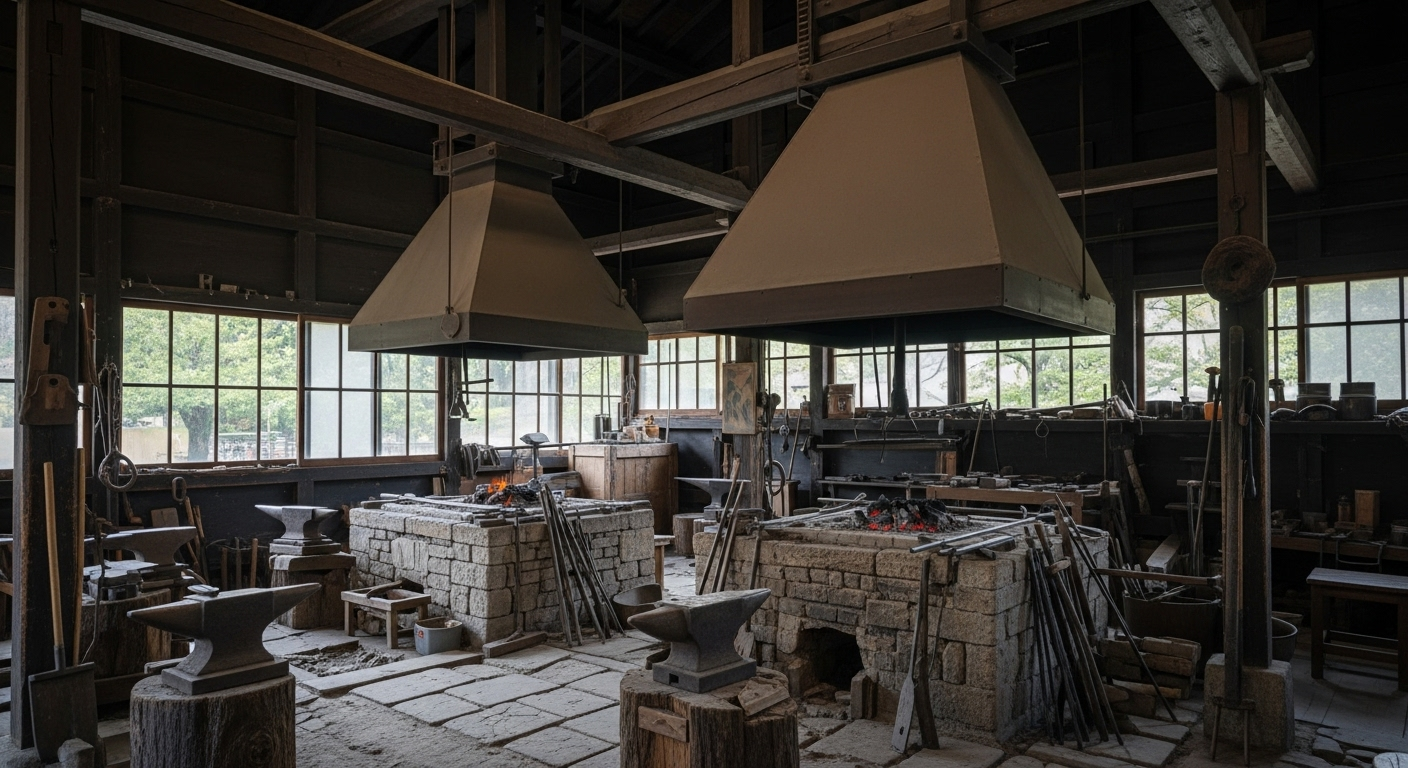
FAQ About Blue Steel #2

Q1. What is Blue Steel #2?
Blue Steel #2 (Aogami No.2) is a traditional Japanese high-carbon steel made by adding small amounts of chromium and tungsten to White Steel #2. This alloying improves toughness and edge retention while preserving the clean, responsive sharpening feel of pure carbon steel. Known for its balance of sharpness, durability, and ease of sharpening, it is a favorite among chefs who need reliable performance in demanding kitchens.
Q2. How is Blue Steel #2 different from Blue Steel #1?
The main difference lies in hardness and toughness. Blue Steel #1 has higher carbon content, making it harder and capable of holding a sharper edge for longer, but it is also more brittle. Blue Steel #2 is slightly softer but tougher, providing greater resistance to chipping and more forgiveness during busy kitchen work. In essence, Blue #1 is for finesse and precision, while Blue #2 is for dependable, all-day professional use.
Q3. Is Blue Steel #2 rust-resistant?
No. Blue Steel #2 is not stainless, but the addition of chromium makes it slightly more resistant to rust than White Steel. Still, it requires attentive care: rinse and dry thoroughly after each use, avoid prolonged contact with acidic or salty foods, and apply a thin layer of oil for long-term storage.
Q4. What types of cooking is it best suited for?
Blue Steel #2 is versatile and well-suited to both delicate and demanding tasks. It excels at slicing sashimi and raw fish, butchering meats with precision, and handling vegetable prep during long hours of service. Whether for refined plating or heavy kitchen prep, it strikes an ideal balance between sharpness and durability.
Q5. Who should choose Blue Steel #2?
This steel is ideal for chefs and serious enthusiasts who want a knife that balances sharpness with durability. It suits those working in professional kitchens where reliability and long-lasting performance are essential, but who still enjoy the responsive sharpening feel of carbon steel.
Q6. How should I maintain a Blue Steel #2 knife?
Care is similar to other carbon steels: wash and dry immediately after each use, store in a dry place, and oil lightly if storing for long periods. Sharpen regularly with waterstones to keep the edge at its best. Avoid cutting through bones, frozen foods, or hard surfaces to prevent damage. With consistent care, a Blue Steel #2 knife becomes a dependable companion for decades.

Comprehensive Guide to White Steel and Blue Steel
White Steel #2 vs. Blue Steel #2: Discover the key differences that shape sharpness, durability, and performance in Japanese knives.

Comprehensive Guide to White Steel #2 and Blue Steel #2
White #2 vs. Blue #2: A deep dive into how subtle differences in carbon content transform sharpness, hardness, and sharpening feel.

Comprehensive Guide to Blue Steel #1 and Blue Steel #2
Blue #1 vs. Blue #2: Explore why small shifts in alloy balance create big differences in edge retention and toughness.

Japanese Knife Materials
The steel behind a Japanese knife defines its sharpness, durability, and care. From traditional carbon steels like White #2 and Blue #2 to modern innovations such as Ginsan and ZDP189, each material offers its own balance of performance and maintenance. This guide explores how these choices shape the knives we use today.
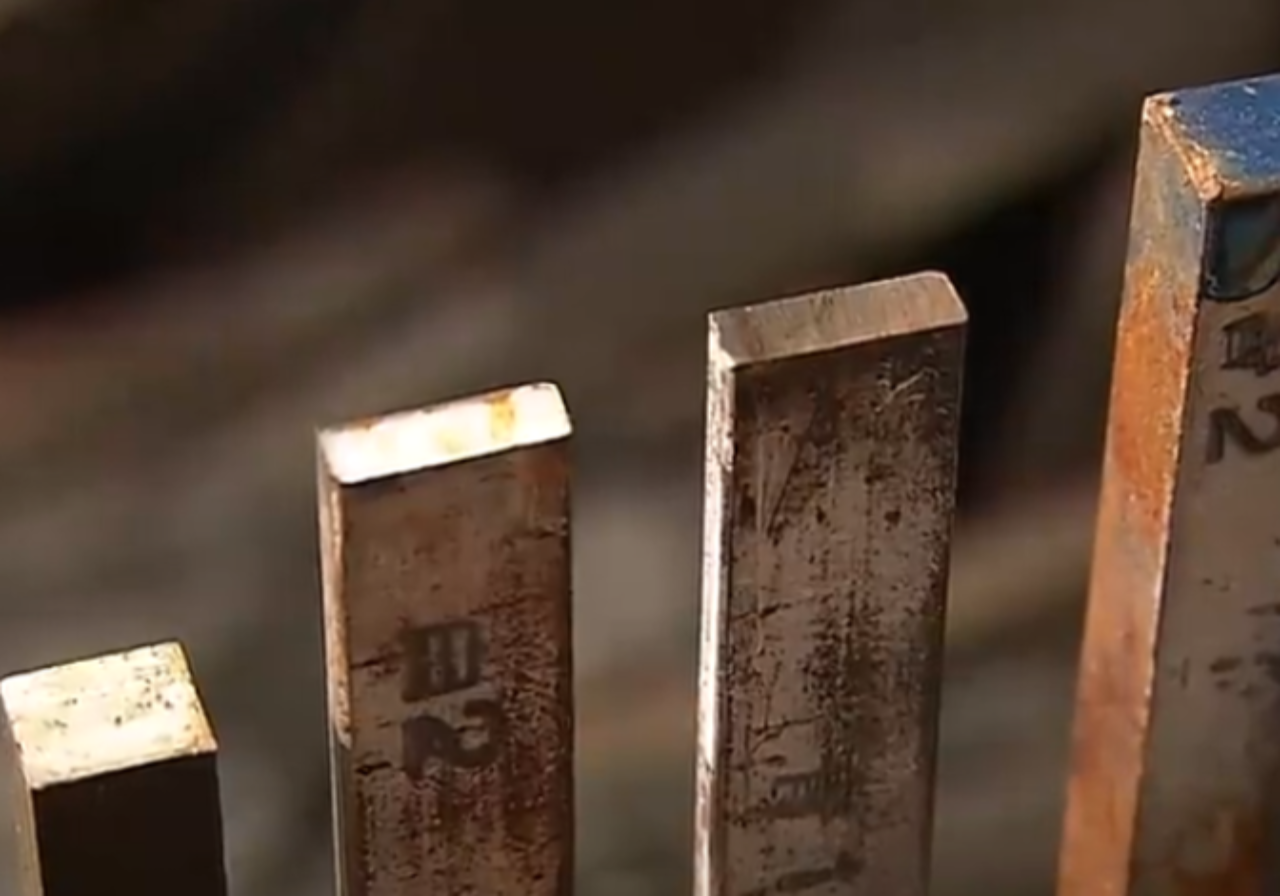
Yasuki Steel: The Heart of Japanese Knives
Yasuki Steel has long been the legendary core of Japanese knife-making. With the 2023 transition from Hitachi Metals to Proterial, its future is at a turning point. The continued yet uncertain production of White and Blue Steel—and the arrival of new stainless options—raises important questions for makers, users, and collectors alike. Understanding Yasuki Steel is more essential than ever to grasp the future of Japanese knives.
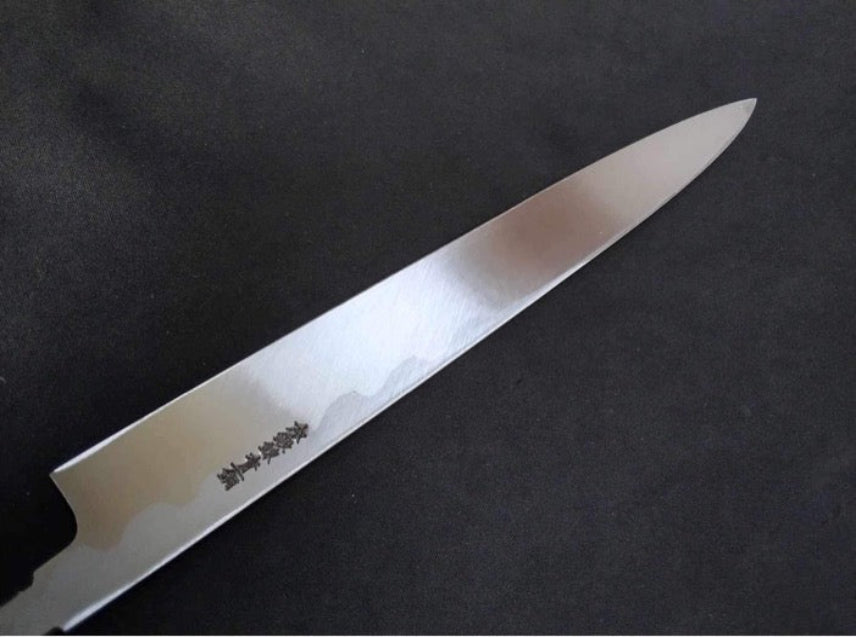
Blue Steel #2: The Perfect Balance of Sharpness and Strength
Blue Steel #2 is one of the most popular materials in Japanese knife-making, valued for its ideal mix of sharpness and durability. Known for its smooth “sweet cutting” feel and long edge retention, it is favored by both professional chefs and passionate home cooks. A Blue Steel #2 knife brings precision, enjoyment, and lasting performance to any kitchen.
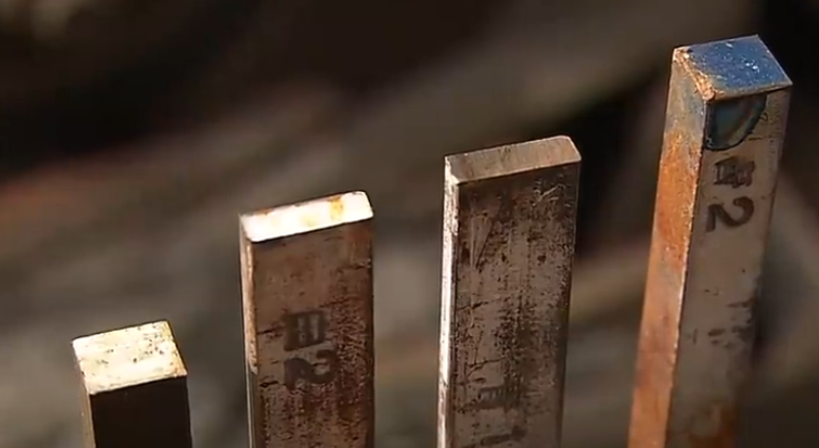
The Soul of Craftsmanship
-
Blue Steel #2: Forged for Endurance, Trusted by Professionals
“For us craftsmen, there is no steel as dependable as Blue Steel #2.”
Its hardness and resilience make it the steel truly worthy of professional kitchens. -
There are steels like White Steel that pursue purity and razor-sharpness, and steels like Blue Steel #1 that aim for the utmost refinement. But Blue Steel #2 is different. Its perfect balance of hardness, toughness, and the ability to revive through sharpening allows it to withstand long hours of use and shine in the most demanding conditions.
-
Chefs often tell me:
“This blade never gives in, even during hours of prep.”
“Even when it meets bone or sinew, it doesn’t chip or break—it protects the integrity of the ingredient.” -
That is the true appeal of Blue Steel #2. While it demands discipline from its user, it always has the strength to respond.
-
Forging this steel is both a challenge and a source of pride for us craftsmen. Tough yet refined—this seeming contradiction is united in Blue Steel #2, making it a blade truly built for professionals. It stands beside the chef, supporting their skill and spirit for years to come.
How Japanese Knives Are Made: The Sakai Tradition
VIDEO PROVIDED: JAPAN TRADITIONAL CRAFTS AOYAMA SQUARE (YOUTUBE)
-
Sakai Forged Blades — Six Centuries of Unrivaled Craftsmanship
Loved by chefs around the world and trusted by 98% of Japan’s top culinary professionals, Sakai knives are more than tools—they are the living legacy of over 600 years of master craftsmanship.
-
At KIREAJI, we work directly with the Shiroyama Knife Workshop in Sakai, Japan, ensuring every blade is hand-forged, finished to perfection, and shipped straight from the workshop to kitchens across the globe. No middlemen. No mass production. Only authentic, artisan-made knives, crafted to elevate your cooking for a lifetime.


